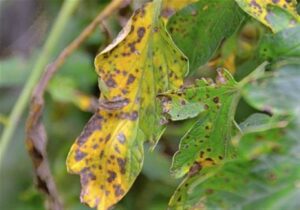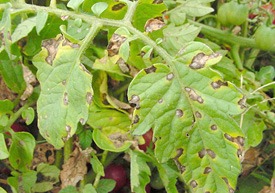Early Blight In Tomatoes
Growing fresh, garden ripened tomatoes, can be a satisfying, rewarding and relaxing hobby for any vegetable gardener. But tomatoes are usually at high risk of infestation by pests and other harmful diseases. Generally, the most common diseases and problems occur due to extensive and prolonged dampness coupled with humidity. Some diseases can also occur due to poorly processed seeds and other factors. The success of our gardens depends highly on our level of commitment to early detection and treatment. But choosing varieties with good to excellent disease resistance can also help us in our battle of early blight in tomatoes .
Symptoms Of Early Blight In Tomato Plants.
 The disease known as Early Blight or Target Spot (because of the concentric circles within the spot) is one of the most common and harmful diseases that affects tomatoes. It can infects stems, leaves and fruits. It may sometimes, although rarely, affect seedlings causing damping-off in the seedbed. Early blight in tomatoes, first becomes evident on the laves of plants. Brown circular spots are often surrounded by a yellow area. Leaf spots usually appear on the oldest, bottom-most leaves first and progress up the plant. As the disease progresses, the fungus may infect the stems, blooms and even fruit.
The disease known as Early Blight or Target Spot (because of the concentric circles within the spot) is one of the most common and harmful diseases that affects tomatoes. It can infects stems, leaves and fruits. It may sometimes, although rarely, affect seedlings causing damping-off in the seedbed. Early blight in tomatoes, first becomes evident on the laves of plants. Brown circular spots are often surrounded by a yellow area. Leaf spots usually appear on the oldest, bottom-most leaves first and progress up the plant. As the disease progresses, the fungus may infect the stems, blooms and even fruit.
You can easily check and take care of your tomato plants. Early blight will often spread quickly, infecting other plants, especially closest ones. At the beginning stages of early blight, the surrounding leaf area turns yellow. The affected leaves die, thus exposing the fruits to sun scald. The early blight fungus prevails in winter and usually spreads due to infected soil. This infection can also spread to plants that belong in the same family, like potatoes.
The spots on the fruit are similar to those on the leaves – brown with dark concentric rings and often begin where the “fruit stalk” adheres to the tomato. Dark, dusty spores are created in concentric rings and can sometimes be seen when a light object is touched on the spot.
Disease Cycle Of Early Blight

Hosts: (Other plants that carry the disease): Tomatoes, potatoes, aubergines, peppers, hot peppers and other nightshades.
Early Blight Control
The best way to manage diseases is to be proactive. Because once it has been established, it can be difficult to control. Examine plants often for any signs or changes. Once the disease starts, fungicides can be used to help control it. I have successfully used two different fungicides to control early blight. (1) Copper Sulfate (2) Serenade Fungicide treatment. Both are very effective methods of controlling blights (both early and late). As always, catching it early would greatly enhance your chances of a successful outcome.
Cultural control methods:
Dry season: In some countries, it is preferable to plant tomatoes in the dry season when there is less moisture in the air and soil. This holds off the early onset of diseases and ensures that there will be a harvest.
Fertilization: Increase the organic matter in the soil as much as possible, especially with old manure or compost. This will encourage healthier plants and reduce chances of diseases, especially earlier on in the season. Healthier plants can also recover better with treatment.
Clean: Destroy tomato plants and fruit waste as soon as the harvest is over. Make a heap and and burn everything. Do not use this compost for tomatoes or other susceptible plants.
Rotation: Crop rotation can also help. If possible, use a different spot for your garden every year or at least every other year. While your last year’s garden is unoccupied, be sure to replenish the soil for future crops. This encourages healthier plants, which, with a little help, can better ward off diseases.





